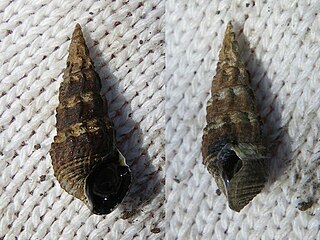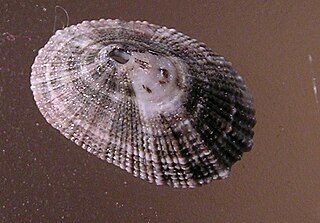Related Research Articles

Heteroconchia is a taxonomic infraclass of diverse bivalve molluscs, belonging to the subclass Autobranchia.

Neritidae, common name the nerites, is a taxonomic family of small to medium-sized saltwater and freshwater snails which have a gill and a distinctive operculum. The family Neritidae includes marine genera such as Nerita, marine and freshwater genera such as Neritina, and freshwater and brackish water genera such as Theodoxus.

The Podocopida are an order of ostracods in the subclass Podocopa. It is the most diverse of the five orders of ostracods, and the only one with freshwater species. The group also has a rich fossil record.

Carcharias is a genus of mackerel sharks belonging to the family Odontaspididae. Once bearing many prehistoric species, all have gone extinct with the exception of the critically endangered sand tiger shark.

Batillaria is a genus of small salt marsh or mudflat snails, marine gastropod mollusks in the family Batillariidae, the horn snails.
Polycopidae is a superfamily of marine ostracods. It is the only superfamily in the suborder Cladocopina.

Verticordiidae is a family of benthic marine bivalves in the superorder Anomalodesmata. These clams range from 2 - 200 millimeters in length and are mainly found in coastal waters surrounding Australia and the Americas, though a few species within this family such as Haliris mediopacifica are found in the middle of the ocean. Verticordiidae is known for being a family of septibranchs, or predatory bivalves, rather than filter feeders. Clams dig vertical burrows in substrate and use papillae around the edges of their inhalant siphons to detect microscopic prey. Some clams in this family, specifically in the genus Trigonulina, have distinct extended circular formations on their shells.

Lottiidae is a family of sea snails, specifically true limpets, marine gastropod mollusks in the superfamily Lottioidea and the clade Patellogastropoda.
The World Register of Marine Species (WoRMS) is a taxonomic database that aims to provide an authoritative and comprehensive list of names of marine organisms.
Bathysciadiidae is a family of sea snails, deep-sea limpets, marine gastropod mollusks in the clade Cocculiniformia.

Helisoma is a genus of freshwater air-breathing snails, a pulmonate gastropod mollusk in the family Planorbidae, the ram's horn snails.
Careliopsis styliformis is a species of sea snail, a marine gastropod mollusk in the family Pyramidellidae, the pyrams and their allies. The species is one of three species within the Careliopsis genus of gastropods, with the exception of the others being Careliopsis clathratula and Careliopsis modesta. The species is one of two species to maintain a binomial authority proposed by Mörch in 1875, the other proposal by Mörch is Careliopsis clathratula.
Fargoa gaudens is a species of sea snail, a marine gastropod mollusk in the family Pyramidellidae, the pyrams and their allies.
Diodora panamensis is a species of sea snail, a marine gastropod mollusk in the family Fissurellidae, the keyhole limpets and slit limpets.

Diodora saturnalis is a species of sea snail, a marine gastropod mollusk in the family Fissurellidae, the keyhole limpets and slit limpets.
Menon is a genus of medium-sized sea snails, marine gastropod mollusks in the family Eulimidae.
Palaeocopida is an order of ostracods in the subclass Podocopa. Most species in the suborder are extinct, and only the genera Manawa, Promanawa and Puncia in the family Punciidae are extant. The members of the family lives in high-energy shallow marine environments of New Zealand.
Haliris is a genus of the class Bivalvia of the family Verticordiidae.
Valenciennellus tripunctulatus, commonly called the constellationfish, is a species of fish in the family Sternoptychidae (hatchetfish).
References
- ↑ "WoRMS - World Register of Marine Species - Cytheromorpha anceps Krutak, 1971". www.marinespecies.org. Retrieved 2017-10-06.
- ↑ "WoRMS - World Register of Marine Species - Cytherura erugata Krutak, 1971". www.marinespecies.org. Retrieved 2017-10-06.
- ↑ "WoRMS - World Register of Marine Species - Loxoconcha tricornata Krutak, 1971". www.marinespecies.org. Retrieved 2017-10-06.
- ↑ "WoRMS - World Register of Marine Species - Loxoconcha tricornata Krutak, 1971". www.marinespecies.org. Retrieved 2017-10-06.
- ↑ "WoRMS - World Register of Marine Species - Protocytheretta ambifaria Krutak, 1971". www.marinespecies.org. Retrieved 2017-10-06.
- ↑ "WoRMS - World Register of Marine Species - Climacoidea (Proteoconcha) costa (Krutak, 1979)". www.marinespecies.org. Retrieved 2017-10-06.
- ↑ "WoRMS - World Register of Marine Species - Hemicyprideis nichuptensis Krutak, 1994". www.marinespecies.org. Retrieved 2017-10-06.
- ↑ "WoRMS - World Register of Marine Species - Paranesidea cancunensis Krutak, 1994". www.marinespecies.org. Retrieved 2017-10-06.
- ↑ "President's Distinguished Scholar Past Recipients - Fort Hays State University". www.fhsu.edu. Retrieved 2017-10-06.
- ↑ "ITIS Standard Report Page: Puriana krutaki". www.itis.gov. Retrieved 2017-10-06.